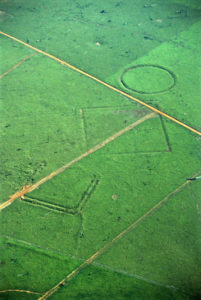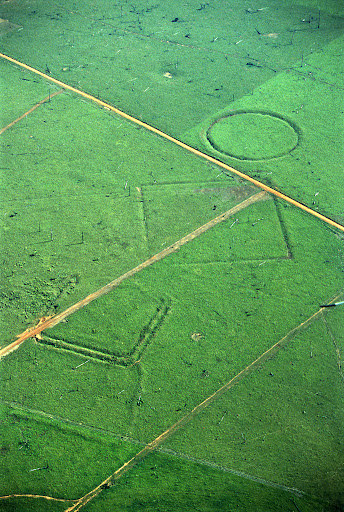
A new study* published by the Proceedings of the National Academy of Sciences suggests that the Amazonian forests in the Acre state of Brazil were managed by human inhabitants for thousands of years, further supporting the theory that much of the Amazon rainforest was already to some extent a product of human design by the time Europeans arrived in the region more than 450 years ago.
Amazonian rainforests once thought to be pristine wildernesses are now known to have been inhabited by large populations before European contact. But how and to what extent these societies impacted their landscape is still controversial. However, in Brazil, scientists and explorers have discovered hundreds of geometric earthworks — over 450 pre-Columbian (pre-AD 1492) geometric ditched enclosures (“geoglyphs”) occupying about 13,000 km2 of the Acre state in Brazil. These huge earthworks were concealed for centuries within the upland interfluvial rainforest, directly challenging the “pristine” status of this ecosystem and its perceived vulnerability to human impacts — suggesting that this region was also deforested to a large extent in the past, challenging the apparent vulnerability of Amazonian forests to human land use. In a study co-authored by Jennifer Watling of the University of Sao Paulo and University of Exeter and colleagues, researchers show that bamboo forest dominated the region for at least 6,000 years and that small, temporary clearings were made to build the geoglyphs; however, construction occurred within an anthropogenic forest, meaning that the forest had already been actively managed by its human inhabitants for millennia. In the absence of widespread deforestation, exploitation of forest products shaped a largely forested landscape that survived intact until the late 20th century. In contrast, the authors suggest, long-term, regional-scale deforestation is primarily a modern phenomenon.
____________________________________
Geoglyphs in the Acre state of Brazil. Sanna Saunaluoma, Wikimeda Commons
_________________________________________________
Article Source: Edited and adapted from the PNAS article summary for “Impact of pre-Columbian “geoglyph” builders on Amazonian forests”*
__________________________________________________
*Jennifer Watling, et al., Impact of pre-Columbian “geoglyph” builders on Amazonian forests, www.pnas.org/cgi/doi/10.1073/pnas.1614359114
__________________________________________________
Subscribe to Popular Archaeology Premium. Available on all laptops and mobile devices, and still the industry’s best value at only $9.00 annually.
___________________________________________
Travel and learn with Far Horizons.
____________________________________________
This richly illustrated issue includes the following stories: Recent findings shedding new light on the whereabouts of the remains of Philip of Macedon, father of Alexander the Great; how an archaeologist-sculptor is bringing bones of the dead back to life; archaeologists uncovering town life at the dawn of civilization; an exclusive interview with internationally acclaimed archaeologist James M. Adovasio about what makes the Meadowcroft Rockshelter prominent in the ongoing search for the first Americans; what archaeologists are finding at the site of the ancient city of Gath, the home town of the biblical Philistine giant, Goliath; and how scientists are redrawing the picture of human evolution in Europe. Find it on Amazon.com.








